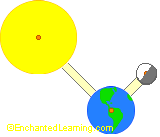
This is a model of the Sun, Earth, and Moon, that shows how the Earth orbits the Sun, and the Moon goes around the Earth.
Nicolaus Copernicus (1473-1543) was a Polish astronomer who developed the Copernican system, a model of the solar system in which the Earth and the other planets orbit the Sun.
- A yellow paper plate (or a white one plus yellow paint) for the Sun
- Scissors
- Three brads (metal paper connectors)
- White cardstock
- A compass for drawing circles, or print a template.
- Crayons or markers
Instructions
Cut out three circles (small, medium, and large) from cardstock or cardboard from a cereal box. [If available, a yellow paper plate makes a nice Sun.]
You’ll need a large circle for the Sun, a medium one for the Earth, and a small one for the Moon.
For a black-and-white template, click here. For a color template, click here. Note: Use the margins of the template for the strips connecting the Sun, Earth, and Moon.
Cut out two strips of cardstock (any color) about 1 inch thick (you can use the marked margins of the templates above). One strip should be aboout 8 inches long and one should be about 5 inches long.
Give the student the three circles. Let them figure out which represents the Sun, the Earth, and the Moon. On each circle, write the name of the celestial object (Sun, Moon, or Earth) on its back.
Color the Sun yellow, color the Earth blue and green, and color the Moon white.
Connect one end of the short (roughly 4-5” long) strip of paper to the center of the back of the Moon using a brad.
Connect the other end of that strip of paper to the center of the Earth (but don’t close the second brad yet).
Connect one end of the long (roughly 8” long) strip of paper to the center of the back of the Earth with the already-open brad.
Connect the other end of that short strip of paper to the center of the sun.
You now have a model of the Sun, the Earth, and the Moon. Note that although the relative sizes of the Earth and the Moon are roughly accurate (about 3:1), the Sun should be much, much larger (the Sun is over 100 times bigger than the Earth).
Also, the Earth is over 370 times farther from the Sun than it is from the Moon. If this model were accurate, the Earth and the Sun should be over 90 feet apart (given that the Earth-Moon distance in the model is about 3 inches).
You can use this model to demonstrate how the Earth orbits around the Sun, and how the Moon orbits around the Earth.
Image: A half moon (also called quarter moon): The moon appears as a half circle.

You can demonstrate how the phases of the Moon are determined by the relative positions of the Moon, Earth, and the Sun. To help do this, color half the moon dark and keep the light side facing the sun.


Solar eclipses (see diagram on the left) and lunar eclipses (see diagram on the right) can be demonstrated using this model.
Image 1: A solar eclipse, when the moon blocks the light of the sun.
Image 2: A lunar eclipse, when the Earth blocks sunlight from hitting the moon.


